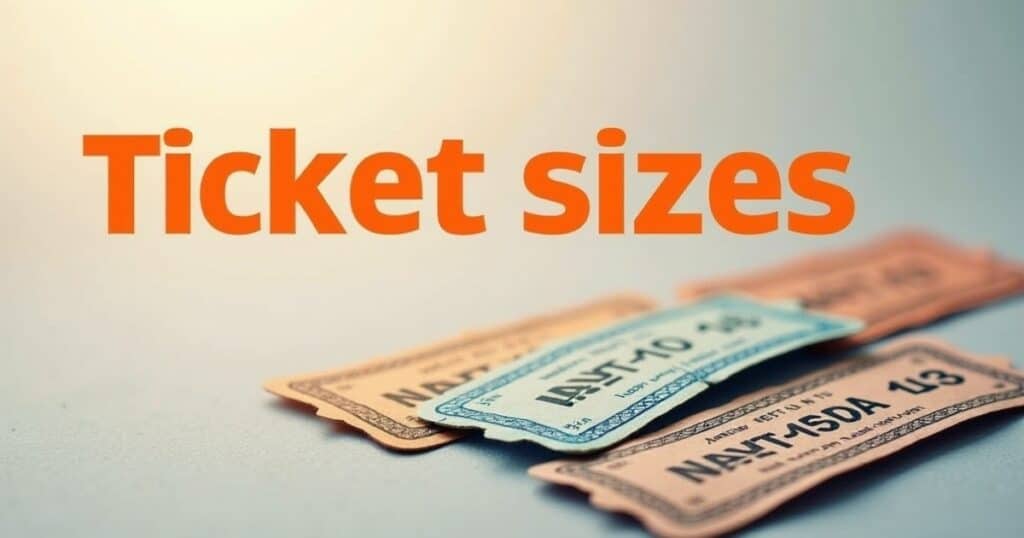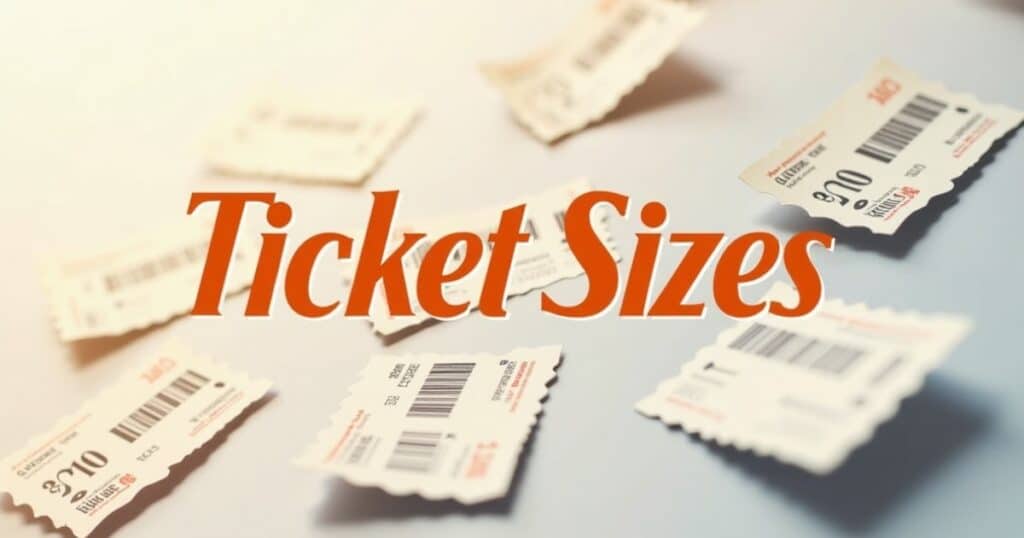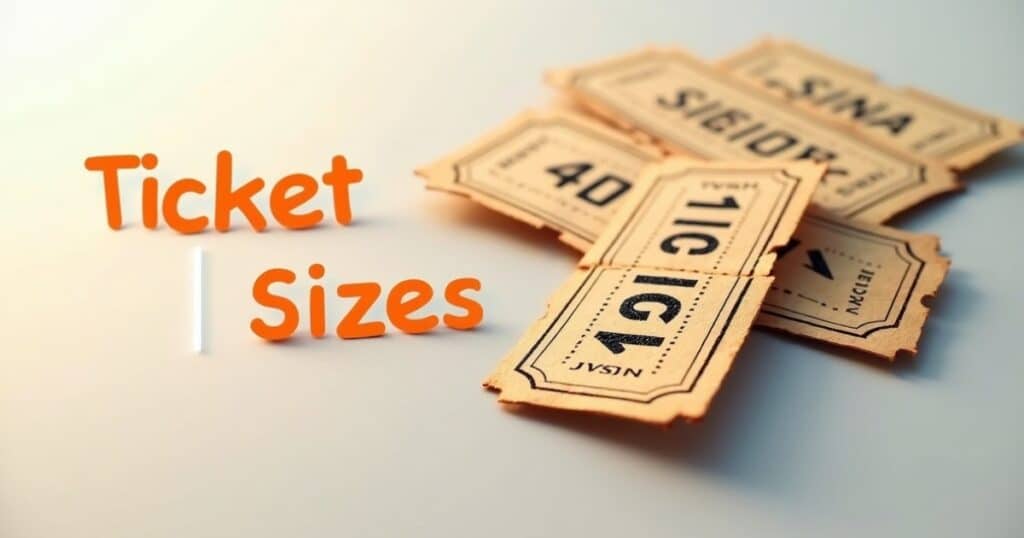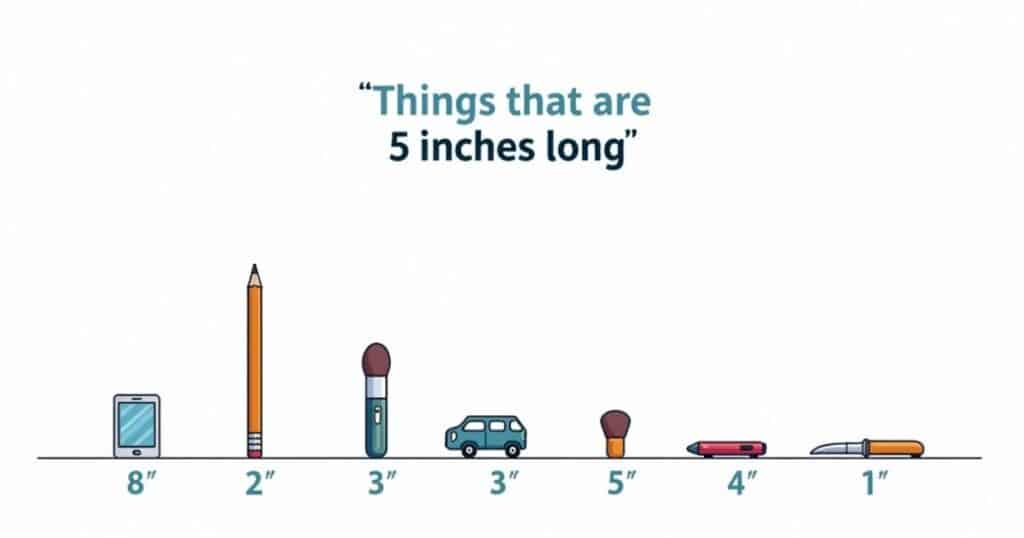Have you ever held a concert ticket in your hand and wondered why it’s sized the way it is? Or noticed how airplane boarding passes differ from movie stubs? Ticket dimensions might seem like a mundane detail, but they’re carefully designed for specific purposes across industries.
From sporting events to transportation, the size and shape of tickets serve practical functions while carrying cultural significance that’s evolved over decades.
How Long Are Standard Tickets?
Most standard event tickets measure approximately 5.5 inches long by 2 inches wide (about 14 cm by 5 cm), though dimensions vary widely depending on their purpose. This size fits comfortably in wallets and pockets while providing enough space for essential information.
To visualize this, think of a standard ticket as slightly longer than a credit card but typically narrower a size that balances convenience with functionality.
The Evolution of Ticket Dimensions
Tickets weren’t always the neat, standardized pieces we know today. Their journey from simple paper tokens to sophisticated security documents tells a fascinating story of technological advancement and cultural shifts.
Early Ticket History
The concept of tickets dates back centuries, with early versions appearing as simple tokens of admission. In ancient Rome, small clay or wooden tablets served as proof of entry to amphitheaters. By the 17th century, theaters in Europe began using paper tickets, though their sizes varied wildly based on local customs and printing capabilities.
“The ticket as we know it today emerged during the industrial revolution,” explains Dr. Martha Keller, curator at the Museum of Ephemera in Chicago. “As mass entertainment grew, so did the need for standardized admission systems.”
The late 19th century saw the first moves toward standardization, especially with the rise of railroad travel. Train tickets needed to fit into conductors’ specialized punches and passenger wallets alike, pushing the industry toward consistent sizing.
The Digital Transformation
The digital age has dramatically transformed ticket dimensions. While physical tickets maintain their importance, e-tickets and mobile passes have revolutionized how we think about admission credentials.
“E-tickets have freed us from physical constraints,” notes James Warren, event technology specialist. “But interestingly, many digital tickets still mimic traditional dimensions on screen our brains are accustomed to that rectangular format.”
Common Ticket Types and Their Dimensions
Concert and Event Tickets
Standard concert tickets typically measure 5.5 inches by 2 inches, though premium tickets for major events might be larger to accommodate enhanced security features or commemorative designs. These tickets often use heavier cardstock (between 80-120 lb) for durability and to prevent counterfeiting.
The back side frequently includes terms and conditions in small print, while the front prominently displays the artist, venue, date, and seat information. Many concert promoters now issue larger commemorative tickets for significant events, sometimes reaching dimensions of 8 by 3 inches to create a keepsake value.
Interesting fact: The world’s largest concert ticket was created for a U2 concert in 2017, measuring a whopping 3 feet by 1 foot as a promotional item that was later auctioned for charity.

Movie Tickets
Movie tickets have shrunk considerably over the years. Traditional movie tickets measure approximately 2.5 by 3.5 inches, designed to fit easily in ticket collection boxes. With the rise of digital ticketing, physical movie stubs have become smaller, with many theaters now issuing receipts barely 2 inches wide.
The compact size serves a practical purpose: theater attendants must quickly tear and check hundreds of tickets during peak hours. Smaller tickets speed up this process while reducing paper waste.
Interesting fact: AMC Theaters briefly experimented with round movie tickets in the 1960s, but quickly abandoned the idea when they proved difficult to stack and store efficiently.
Sporting Event Tickets
Sports tickets vary widely by league and venue. NFL tickets typically measure about 6 inches by 2.5 inches, while MLB tickets are often slightly smaller at 5.5 by 2 inches. Major sporting events like the Super Bowl or World Series issue larger commemorative tickets, sometimes reaching 7 inches in length.
These tickets frequently incorporate advanced security features like holograms, microprinting, and specialized UV-reactive inks to prevent counterfeiting. The larger size accommodates these features while creating a more substantial keepsake.
Interesting fact: Super Bowl tickets have grown increasingly elaborate over the years, with recent versions incorporating RFID chips and featuring dimensional printing techniques that create tactile surfaces.
Transportation Tickets
Airline boarding passes traditionally measured 8 by 3 inches when printed at airport countersa size designed to fit easily in passport holders while displaying crucial information. Train tickets vary by country and operator, but European rail tickets typically measure about 3.5 by 2 inches.
Bus tickets tend to be the smallest transportation tickets, often just 2 by 1 inch small enough to be easily dispensed from automated machines and checked quickly by drivers.
Interesting fact: Japan’s bullet train tickets are designed with precise dimensions that allow them to be inserted into automated gates at exactly the right speed, with magnetic strips that must align perfectly for validation.

The Science Behind Ticket Design
Ticket dimensions aren’t arbitrary they’re carefully calculated based on psychology, ergonomics, and practical needs.
Psychological Factors in Ticket Design
“The physical dimensions of a ticket actually affect how we value the experience,” explains consumer psychologist Dr. Helen Zhang. “Larger, heavier tickets create a perception of greater value and importance.”
This psychological principle explains why premium events often use thicker cardstock and larger dimensions it subtly reinforces the event’s significance before it even begins.
See Also: Index Card Dimensions: A Complete Guide
Practical Considerations
Practical factors also dictate ticket dimensions:
- Storage requirements: Tickets must fit standard storage systems, from cash registers to filing systems.
- Handling efficiency: Staff must be able to quickly process tickets during peak entry times.
- Information needs: The ticket must be large enough to include essential information while remaining readable.
- Security features: More valuable events require space for advanced anti-counterfeiting measures.
- Branding opportunities: Promoters need adequate space for logos and event branding.
The Security Revolution in Ticket Dimensions
Modern tickets are sophisticated security documents, with dimensions often dictated by security needs rather than just practical handling.
“Every millimeter matters in ticket security,” explains Marcy Davidson, security printing specialist. “We need precise space for holograms, microprinting, and specialized inks.”
Major sporting events and concerts now incorporate multiple security elements that require specific dimensional considerations:
- Holographic overlays need minimum surface areas to be effective
- Microprinting requires space for specialized printing plates
- Thermochromic inks (which change color with temperature) need sufficient coverage
These security requirements have generally pushed tickets toward slightly larger dimensions in high-value events, though digital ticketing is reversing this trend.
The Future of Ticket Dimensions
As technology evolves, physical ticket dimensions face new challenges and opportunities.
The Rise of Smart Tickets
RFID and NFC-embedded tickets are changing dimensional requirements. These “smart tickets” need space for embedded chips while maintaining structural integrity. Some major festivals now issue wristbands rather than traditional tickets, completely reimagining the concept of admission credentials.
“The wristband revolution changed everything,” says event promoter Carlos Rodriguez. “We’re no longer constrained by paper dimensions, but we’re adding new requirements for comfort and durability.”
Environmental Considerations
Sustainability concerns are driving smaller ticket dimensions or eliminating physical tickets altogether. Many venues now use minimalist designs that reduce paper waste while maintaining functionality.
The average sporting event produces over 50 pounds of discarded ticket paper. This environmental impact has pushed many organizations toward digital solutions or smaller physical tickets made from recycled materials.
Practical Applications: Measuring and Using Ticket Dimensions
Understanding ticket dimensions has practical applications beyond trivia knowledge. If you’re designing event materials, planning storage systems, or creating commemorative displays, knowing standard ticket sizes is essential.

How to Measure Tickets Without a Ruler
No ruler handy? You can estimate ticket dimensions using common objects:
- A standard credit card is 3.37 inches long most tickets are about 1.5 times this length
- A dollar bill is 6.14 inches long slightly longer than most standard tickets
- A smartphone is typically 5-6 inches tall roughly the length of a standard ticket
DIY Ticket Holders and Displays
Understanding ticket dimensions allows you to create custom storage solutions:
- Memory books: Standard photo albums typically accommodate concert tickets without modification.
- Shadow boxes: A standard 8×10 shadow box can display 4-6 typical event tickets.
- Custom frames: When framing memorabilia, allow for ticket dimensions plus a half-inch border for mounting.
Industry Standards and Variations
While ticket dimensions vary widely, certain industries have established standards:
- IATA standard boarding passes: 8 × 3 inches for traditional counter-printed passes
- Ticketmaster standard: 5.5 × 2 inches for most concert venues
- MLB standard: 5.5 × 2 inches for regular season games
- Movie tickets: Typically 2.5 × 3.5 inches, though increasingly variable
These standards create consistency for handling equipment and storage systems while meeting consumer expectations.
See Also: GoodNotes Paper Size: The Complete Guide
Cultural Significance of Ticket Dimensions
Beyond practical considerations, ticket dimensions carry cultural significance. The tangible nature of physical tickets creates emotional connections that digital alternatives struggle to replicate.
“There’s something deeply meaningful about the weight and size of a physical ticket,” notes cultural anthropologist Dr. James Morton. “It’s a tangible promise of an experience to come.”
Many concert-goers and sports fans maintain collections of ticket stubs, with the physical dimensions forming an important part of the display aesthetic. The standardized sizing creates a visual consistency that collectors appreciate.
Collectibility Factors
Ticket dimensions directly impact collectible value. Oversized commemorative tickets typically command higher prices in memorabilia markets, while standard-sized tickets from extraordinary events (like perfect games in baseball) maintain value regardless of their dimensions.
“The standard dimensions actually help authenticate vintage tickets,” explains memorabilia appraiser Sandra Williams. “Counterfeit collectors’ items often get the subtle size details wrong.”
Conclusion
Ticket dimensions represent the intersection of practical design, security needs, cultural traditions, and technological evolution. While we rarely consciously notice ticket sizes, they influence our experiences in subtle but significant ways from how easily we store them to the psychological value we attach to the events they represent.
As we increasingly move toward digital ticketing, understanding the history and significance of physical ticket dimensions helps us appreciate this often-overlooked aspect of design history. Whether you’re a collector preserving memorabilia or an event planner designing new admission systems, ticket dimensions matter more than most people realize.
Next time you hold a ticket, take a moment to notice its dimensions and design. That small rectangle represents centuries of evolution in admission control, security printing, and cultural practices all compressed into a piece of paper that fits in your wallet but opens doors to extraordinary experiences.
Look around your home how many tickets of different dimensions can you find? Each one tells a story not just of the event it granted access to, but of the careful design considerations that created its perfect size and shape.
Read more knowledgeable blogs on Measure Take.



